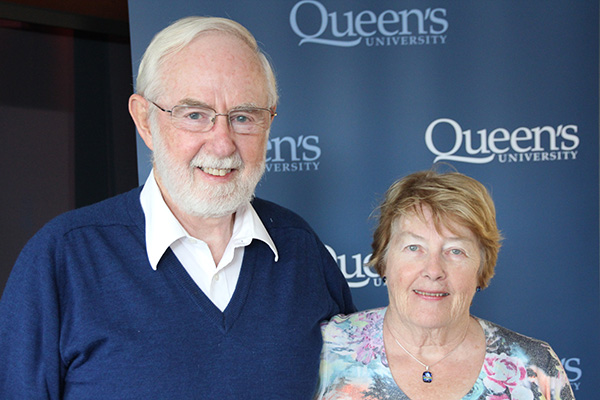Of neutrinos and oscillations
April 29, 2016
Share
Professor Emeritus Art McDonald’s winning of the 2015 Nobel Prize in Physics is one of the greatest moments in the history of Queen’s University and, fittingly, now has been honoured with a musical tribute.
Composed by John Burge (Music), the piece – OSCILLATIONS – was requested by Provost Alan Harrison in December after Dr. McDonald received the Nobel Prize along with Takaaki Kajita of the University of Tokyo. In creating the musical piece Dr. Burge turned to his personal connection with the McDonalds for inspiration.
“Art is an incredibly gracious soul and Queen’s is lucky to have had his leadership over the years,” Dr. Burge says. “I actually knew Janet McDonald as a piano teacher in Kingston and a fellow member of the Kingston branch of the Ontario Registered Music Teachers’ Association prior to meeting Art. Art would often join Janet at the year-end ORMTA Kingston dinner and I recall sitting with him a number of times. He is a wealth of knowledge and obviously has an inquisitive and resourceful mind – qualities that I truly believe are reflected in our best students, regardless of the discipline of study or research.”

As an acknowledgement of Janet McDonald’s piano credentials Dr. Burge decided OSCILLATIONS would be a solo piano piece. He also drew upon Dr. McDonald’s research at the Department of Physics, Engineering Physics and Astronomy and the Sudbury Neutrino Observatory as well as his breakthrough finding that neutrinos change identities, or oscillate, and therefore are not massless, as once thought.
“One of the great things about music is its ability to be highly descriptive in a programmatic fashion or to capture a mood that has certain emotional resonances,” Dr. Burge says, adding that once he decided to write a solo piano piece, “it was simply a matter of finding somewhat repetitive patterns that overlap and evolve into other patterns. At the same time, I wanted the piece to have a ‘romantic’ core that comes through quite prominently towards the end of the piece. There is a circular element to the piece’s structural design that creates a strong sense of closure although the implication is that the piece could continue to cycle along for an infinite duration.”
Dr. Burge says that the composition was sketched out over a few evenings in December “when I should have been working on other projects.” However, the pull of the invitation “was highly inspirational and I simply had to put pencil to paper to get the notes out of my system.”
He then polished and refined the piece and premiered it Thursday, April 28 at a special dinner in Dr. McDonald’s honour hosted by Principal Daniel Woolf in Toronto.